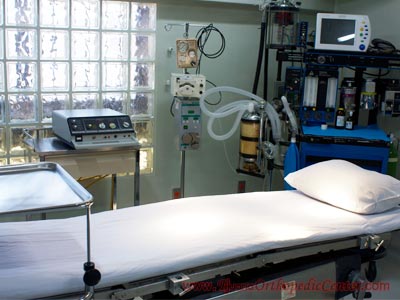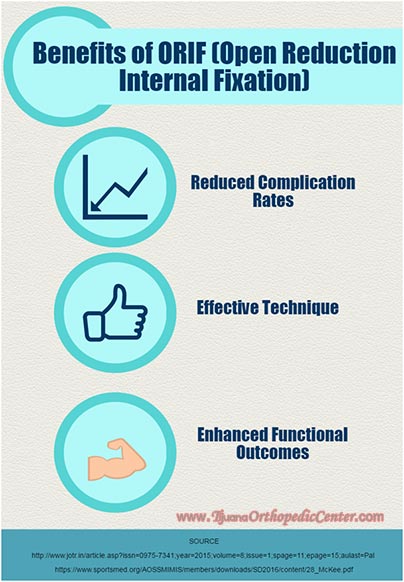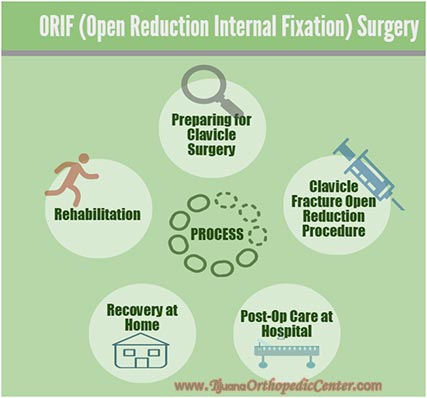Clavicle Fracture Open Reduction in Tijuana at $3,800
A severe injury to the collarbone may result in a clavicle fracture or a broken collarbone. Sometimes when the fracture does not repair itself through immobilization (in sling) and physical therapy, surgical intervention may be required.
The surgical procedure to repair a broken collarbone involves ORIF (Open Reduction Internal Fixation) Surgery. The following conditions require surgical intervention:
- Multiple clavicle fractures
- Open clavicle fracture
- Injury to nerve structures
According to a study by Alan J Micev of Feinberg School of Medicine, Chicago, USA, 2.6% of all fractures are clavicle fractures1.
How can We Help With Clavicle Fracture Open Reduction?
- Tijuana Orthopedic Center (TOC) has experienced surgeons and dedicated support staff. They speak fluent English.
- For your convenience and ease, assistance with paperwork and lodging is also available
- Medical loans for orthopedic surgery are also available for those who want to finance their clavicle fracture surgery.
Schedule an Appointment for ORIF Surgery in Tijuana
- Fill our FREE estimate form.
- Upon receiving your request, our representative will get back to you via email or phone.
Benefits of Surgical Treatment
Reduced complication and non-union rates
A study conducted by Michael D. McKee published in The American Orthopaedic Society for Sports Medicine states surgical intervention to treat a fractured clavicle has low complication and non-union rates of 2.2%2. This means a cutback of 86% in risks as compared to non-surgical treatments2.
Effective technique
The study by Michael D. McKee found that surgical intervention is an effective technique as compared to non-operative treatment of clavicle fractures which has disappointing patient related outcomes of 31%2.
Enhanced functional outcomes
According to a study (2015) by CP Pal and colleagues, an improvement of 93.7% was noted with no major complications3.
How do I know if I have broken a collarbone?
If your collarbone has broken you may have a bump or protruding skin from the collarbone area. Swelling and numbness may be present. Other symptoms include:
- Pain in the collarbone area
- Difficulty moving the arm
- Slumped shoulder
Is ORIF better than conservative treatment?
In this regard, the following was noted in the study by CP Pal and colleagues:
- With ORIF treatment the fractures healed completely in 91.7% of the individuals between 12-24 weeks 3
- On the contrary, the conservative treatment had a success rate of only 60%3
Preparing for Surgery
We recommend arriving at the Tijuana Orthopedic Center a day before the surgery and come the next day for a follow-up visit. Some other points to consider include:
- Make sure you inform your surgeon of any previous medical problems (if any) that you’ve had or if you are taking any medication regarding the same.
- If you are allergic to some medication, inform your doctor about it.
- Tell your doctor about any recent changes to your health, like fever or infection.
- The doctor may ask for X-ray, CT Scan or MRI and blood tests.
- Anti-inflammatory or any other medicine (that the surgeon asks for) must be discontinued before the surgery to prevent complications from arising.
- Quit smoking and consuming alcohol as doing so reduces the infection risk.
- On the night before the surgery, you will be told not to eat or drink anything after midnight to reduce your chances of vomiting.
Procedure for Clavicle Fracture Open Reduction Surgery
- Depending on your treatment plan, general anesthesia will be administered.
- Your pulse rate and blood pressure etc will be monitored during the surgery.
- Time taken for surgery (correlate with clinical studies).
- The fractured collarbone is accessed via making an incision in the area.
- ORIF (Open Reduction Internal Fixation) surgery is accomplished via titanium steel plates which are fixed along the bone via a number of screws.
- The opening is then closed with sutures.
Recovery Post-Op
In Hospital
- Your shoulder will be in the sling and immobilized.
- There will pain as soon as anesthesia wears off. To control the pain, medication will be administered.
- To control swelling, ice packs may be used.
- It is advisable to keep your arm in sling for about 6-8 weeks.

At Home
You won’t be able to drive till the time your shoulder is in sling. Your surgeon will let you know when you can do so. Don’t forget to ask your family or close friend for help at home. Here are some tips on how to live with an immobilized shoulder for a few days:
- Rest and continue with ice packs to help decrease swelling for three to four times in a day.
- Two to seven days after the surgery, you can remove the bandage and bathe on a regular basis.
- Remember not to involve in rigorous activities such as lifting, and avoid any jerky movements.
- Move your fingers in sling to help with blood circulation.
- Mild exercises may be recommended in this stage.
Call TOC in case you come across any of the following:
- Uneasiness in sling, like rashes on skin
- Leakage from or redness or swelling around the incision area
- Loss of sensation in your arm or hand
- Fever of 100.4°F (38°C) or higher
- Unbearable pain
- Trouble moving fingers
Rehabilitation
Rehabilitation exercises may begin after 3 weeks of rest in the sling and could include:
- Pendulum exercises and forward motions of the shoulder
- Arm and hand flexing
- Grip strengthening exercises
- Rigorous exercises after 4 months
Points to Consider
Consider the following to avoid an injury to the collarbone:
- To reduce your chances of repeating the collarbone injury, follow a strict routine of exercise and include shoulder strengthening exercises.
- For individuals in sports such as football and hockey, make sure to wear support on the shoulder which will help in preventing injuries to the clavicle.
- Do not delay meeting the doctor in case there is pain and swelling on the affected shoulder.
We also offer shoulder arthroscopy in Tijuana, besides knee replacement, knee cartilage resurfacing surgery and ankle reconstruction surgery.
For more information, fill in the quote-request form.
References:
- Micev AJ (2016) The Rising Incidence of Operative Treatment of Mid-shaft Clavicle Fractures. Orthop Muscular Syst 5:211. doi:10.4172/2161-0533.1000211. http://www.omicsonline.org/open-access/the-rising-incidence-of-operative-treatment-of-midshaft-clavicle-fractures-2161-0533-1000211.php?aid=73167
- OTA/ AOSSM Specialty Day 2016. Displaced Clavicle Fractures: Surgery Provides Better Results. Michael D. McKee Professor, Division of Orthopaedic Surgery Department of Surgery, St. Michael’s Hospital and the University of Toronto, Toronto, Canada. https://www.sportsmed.org/AOSSMIMIS/members/downloads/SD2016/content/28_McKee.pdf
- Pal CP, Shakunt RK, Kumar D, Goyal A, Tyagi AP, Pippal TC. Functional outcome of conservative and surgical management in mid-third clavicle fractures. J Orthop Traumatol Rehabil 2015;8:11-5. http://www.jotr.in/article.asp?issn=0975-7341;year=2015;volume=8;issue=1;spage=11;epage=15;aulast=Pal




